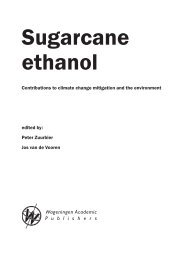Production and use of fuel ethanol in Brazil - BAFF
Production and use of fuel ethanol in Brazil - BAFF
Production and use of fuel ethanol in Brazil - BAFF
Create successful ePaper yourself
Turn your PDF publications into a flip-book with our unique Google optimized e-Paper software.
36<br />
A4.5.<br />
How is sugar-cane paid for <strong>in</strong> São Paulo State?<br />
Sugar-cane can be grown either by the <strong>in</strong>dustrial plant itself — <strong>in</strong> owned or leased<br />
l<strong>and</strong>s or through farm<strong>in</strong>g companies related to the same bus<strong>in</strong>ess group — or third<br />
parties, usually natural persons, who are referred to as sugar cane suppliers.<br />
Sugar-cane suppliers always sell their production to the process<strong>in</strong>g plants located<br />
near their rural property beca<strong>use</strong> <strong>of</strong> two factors: 1. Sugar-cane quality deteriorates<br />
if it takes too long to deliver it (refer to question 4.1); <strong>and</strong> 2. Excessive long-haul<br />
transportation costs. Such fact w<strong>in</strong>ds up limit<strong>in</strong>g the number <strong>of</strong> plants which whom<br />
suppliers can negotiate their production.<br />
In order to prevent an unbalance <strong>in</strong> that relationship, a jo<strong>in</strong>t work conducted by<br />
the association that represents São Paulo-based sugar-cane suppliers (Orplana<br />
— Organization <strong>of</strong> Sugar-cane Growers <strong>of</strong> <strong>Brazil</strong>’s Center-South Region) <strong>and</strong> the<br />
association that represents São Paulo-based sugar <strong>and</strong> <strong>ethanol</strong> <strong>in</strong>dustries (Unica<br />
— Sugar-Cane Industry’s Union) created a system <strong>in</strong> 1999, for free adoption, that<br />
aims to set parameters for a fair, appropriate remuneration <strong>of</strong> producers.<br />
By the name <strong>of</strong> CONSECANA, the system goes by the pr<strong>in</strong>ciple <strong>of</strong> apportion<strong>in</strong>g<br />
the net <strong>in</strong>come —net <strong>of</strong> taxes— from sugar <strong>and</strong> <strong>ethanol</strong> sales among sugar-cane<br />
suppliers <strong>and</strong> the <strong>in</strong>dustry. To that end, it <strong>use</strong>s:<br />
1. a technical method to assess the quality <strong>of</strong> the sugar-cane delivered by the<br />
supplier, <strong>in</strong> terms <strong>of</strong> the amount <strong>of</strong> sugars usable <strong>in</strong> the <strong>in</strong>dustrial process<br />
that it conta<strong>in</strong>s;<br />
2. the means farm<strong>in</strong>g <strong>and</strong> <strong>in</strong>dustrial process<strong>in</strong>g costs;<br />
3. the price for the end products, i.e. sugar <strong>and</strong> <strong>ethanol</strong>, either for the<br />
domestic market or exports, asked <strong>in</strong> the course <strong>of</strong> the crop year (May<br />
through April <strong>of</strong> the next year);<br />
4. the characteristics <strong>of</strong> each <strong>in</strong>dustrial plant’s production <strong>and</strong> market<strong>in</strong>g<br />
activity for the crop year; these characteristics consist <strong>of</strong> the amount<br />
produced <strong>of</strong> each product (sugar <strong>and</strong> <strong>ethanol</strong>) <strong>and</strong> the end <strong>use</strong> after sale<br />
(<strong>use</strong> as <strong>fuel</strong>, export, etc.).<br />
A. Fuel <strong>ethanol</strong>: Activities <strong>in</strong> <strong>Brazil</strong> <strong>and</strong> the world context












